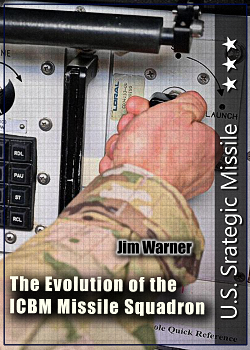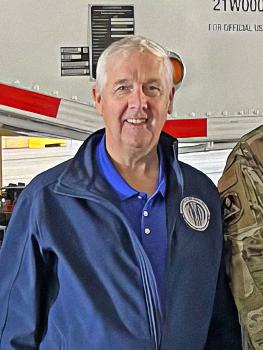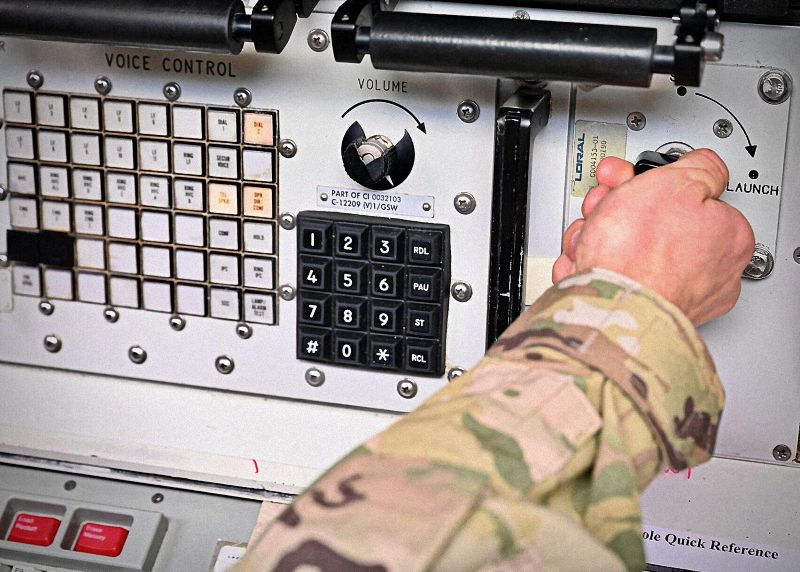|
|
|
|
|
Jim Warner
© «AAFM», August, 2023.
Our address: en@rvsn.info |
|
See also:
The Evolution of the ICBM Missile Squadron «AAFM», August, 2023. Newsletter of «Association of Air Force Missileers» .
Executive Director’s note: After writing a few articles on current ICBM activities it became clear to me through your comments that if you pulled alerts before 1994, some of the terminology related to current operations might not be comparable to your experiences. In the same vein, when I use pre-1994 terminology with our current missileers, I sometimes get the deer in the headlights response. Hopefully this article will bridge the gap for many of you and provide context for future newsletter articles. The construct and makeup of the Minuteman missile wing and specifically the missile operations squadron has seen several name changes over the years. They were originally called Strategic Missile Squadrons until “Strategic” was dropped in 1991, a year before the deactivation of Strategic Air Command (SAC). Then came “MLS" under Air Combat Command followed by “MIS" under Air Force Space Command (AFSPC). Today, the missile squadrons are designated as “MS”. In addition to name changes, the structure and makeup of the squadrons have changed. Despite these changes, the mission remains the same. When I was assigned to my first operations squadron in 1974, (the 68th Strategic Missile Squadron, 44th Strategic Missile Wing, Ellsworth AFB, SD), leadership from the wing to the squadron and many of the flights was saturated with pilots on a “rated supplement” as part of a pilot drawdown at the end of the Vietnam war. Over the subsequent years, the organizational structure and the experience of the men and women of the squadron changed significantly. After a significant period of time of “growing our own”, the first impact was the downsizing of the ICBM force from 1054 missiles across 9 missile wings for the Titan and Minuteman weapon systems and two numbered Air Forces (8th and 15th). Titan started deactivation in 1982 and was completed in 1987. At the same time, 50 Minuteman silos were converted to Peacekeeper which became operational in 1987. In 1991, as a result of START I, Minuteman units at Ellsworth, Grand Forks, and Whiteman were deactivated with the drawdown complete in 1994 leaving 500 Minuteman and 50 Peacekeepers (which were then deactivated in 2005). In 2008, the 564 MS (Deuce) deactivated, resulting in the current 450 LFs that comprise the ICBM force. During that period, crossflows between missiles and space became the new reality. In 2008, the Air Force stood up Air Force Global Strike Command which was the first time since SAC was deactivated in 1992 that the Air Force had its nuclear forces under one command. With the creation of the Force Improvement Program in 2014, we started rebuilding and retaining our own missile culture again, this time with eyes wide open. Currently, discussions between Air Force Personnel Center and Air Force Global Strike Command are ongoing to determine the changes required to field Sentinel forces. Prior to the end of SAC in 1992, the wing model comprised of a Wing Commander and staff which included a Deputy Commander for Operations (DCO or DO), a Deputy Commander for Maintenance (DCM or MA), a Deputy Commander for Resource Management (RM) (transportation and supply), Hospital Commander, and a Combat Support Group or Base Commander (mission support, security, civil engineering, communications). Within the Deputy Commander for Operations were the Operations Squadrons, the Training Division (DOT), which included the Instructor Branch (DOTI), Missile Procedures Branch (DOTM), and the Scheduling Branch (DOTS), the Standardization and Evaluation Division (DOV), the Plans and Intelligence Division which included the EWO Branch (DO22T) and the Targeting Branch (DO22X), the Codes [7] Division (DO9) and the Facilities Management Division (DO24). A missileer and Air Force history buff told me recently, no single person changed the structure of the Air Force more than General Tony McPeak during his tenure as Chief of Staff of the Air Force. On July 1, 1994, the Operations Squadron went through a major reorganization as part of McPeak’s creation of the Objective Wing— “One Base, One Wing, One Boss” concept. As then Lt Col Mike Lehnertz, 400 SMS/CC, remembered: “There was a formation on the parade field and we were all in formation by Operations, Maintenance, and Security Force organizations. Brig Gen Neary, 90 MW/CC, gave a short speech about upcoming events. At the conclusion of General Neary’s speech an order was given to execute the reorganization.” As the AFSPC Command History reports, the 90th Missile Wing’s organizational structure changed this period with the reorganization of the wing on 1 July 1994. By order from higher headquarters, the wing realigned as an objective wing that sized down from five groups to four. The 90th Security Police Group inactivated on 30 June 1994 and personnel from that group filtered in with the 90th Operations Group thus making the 90th Missile Wing the parent unit of four groups. The security policemen and women from the 88th Missile Security Squadron (MSS), 89 MSS, 90 MSS, and the 90th Security Support Squadron were assigned to either the 319th Missile Squadron (MS), 320 MS, 321 MS, 400 MS or the 90th Operations Support Squadron (OSS), depending on their specific duties as an Air Force cop. For instance, 90 MSS’s personnel were responsible for the security of the 400 MS’s missile sites, therefore, the 90 MSS’s security personnel were assigned to the 400 MS. Additionally, the security policemen and women of the 90th Security Police Squadron were reassigned to the 90th Support Group. Moreover, the 90th Logistics Group reorganized within its own structure. In the late 1970’s the 90th Missile Maintenance Squadron divided into two squadrons; 90th Field Missile Maintenance Squadron and 90th Organizational Missile Maintenance Squadron. Since then, these two units have operated solely within the 90th Logistics Group. On 1 July 1994, these two units combined again and became the 90th Maintenance Squadron. The same actions occurred at all Minuteman operational units. In 1996, food services operations completed the transfer of more than 300 chefs from base services squadrons into missile squadrons. As noted in the AFSPC history: “From this point forward, everyone working at a missile alert facility is now a member of the same squadron, making the word ‘team’ more meaningful”. The new objective wing structure changed the role and responsibilities of missile operators for years to come. The reorganization directed the change of the DCO to the standup of the Operations Group (OG) which included the standup of the Operationas Support Squadron for all the former DCO functions, moved the DCM function to the standup of the Logistics Group (LG) for host wings and Maintenance Group (MG) for Minot and saw the reassignment of the base commander to the Support Group Commander. As one commander would later reflect, “it truly gave operators the opportunity to experience the ‘leadership challenge’”. Instead of just worrying about alert coverage and crew certifications, now they experienced guard mount, recapture exercises, and most likely their first late night DUI call. As a maintenance squadron commander a few years before this, I experienced more letters of reprimand and Article 15s in one month than the average operations squadron commander experienced in a lifetime, it was just the nature of the organizations. I learned quickly the importance of strong senior NCO leadership and a great first sergeant (mine were CMSgt Farmer and MSgt Job). For the better part of the next decade, operators would get the full force of that opportunity. The Missile Squadron commanders were now getting that experience with a fire hose. Several former commanders that I talked to shared that they enjoyed the challenges and gained new leadership insights. Research shows the foundation of the Objective Wing concept came from the “ideal” fighter wing where the squadron commander needed all of the resources under his control to generate sorties. Since the direction for the implementation for the objective wing came from the CSAF, there was no question on whether it was right for ICBMs or whether it would get done. In the ICBM world, the change gave the missile squadron commander the operators for the mission, the chefs and FMs for topside support, the security forces needed to protect the MAFs and LFs, and the maintenance teams needed to perform tape load and startup to bring the sortie to alert. The Air Force, in its attempt to make all things look the same, again forgot that the culture of a 24/7/365 alert posture and the “ICBM flight line” was significantly different than generating an aircraft for a mission. Operators had no training on security force tactics [8] and procedures, and no insight into their force development. At a time where almost 75% of the Air Force security personnel were assigned to ICBMs, leadership opportunities for young officers in security forces were disappearing. Maintenance organizations had a large chunk of their electronics technicians (2M0X1) pulled from their resources and were now supporting an outside organization with their limited resources. The standup of the Operations Support Squadron (OSS) consumed the previous DO level organizations of training, codes, MPT management, scheduling and EWO support. At the same time, the training functions (former DOTI) were moved out of the “DO Level” and transitioned to a squadron responsibility. While the new structure was a great opportunity for mission cohesion and leadership development within the OG, its structure was having other unforeseen impacts such as the future growth of security forces officers within ICBMs. According to Col (ret) Blaine McAlpin, “the EMT teams were moved back to the Missile Maintenance Squadron in 1995 due to inefficiencies discovered in decentralization. It was not uncommon for a camper in one squadron to not get worked because of higher priorities, while EMT in another squadron went untasked on the same day. At Malmstrom it created four sets of overhead and management, and created issues moving X1s back and forth between the operations squadrons and management positions in maintenance.” While serving as the 20 AF/CC, Maj Gen (ret) Tim McMahon was one of those who saw other impacts and successfully advocated for the standup of a Security Forces Group. “I was convinced that security forces in the ops squadrons was a poor fit and that security forces needed senior (Colonel) leadership…. someone to focus on unit cohesion, force development, standardization of tactics, techniques, and procedures and of course a single budget for security forces.” In 2002, the Air Force announced a new wing structure with five groups: operations, maintenance, mission support, security forces and medical. From the Command History: “The Operations Group consists of operators, facility managers, aircrew members and support personnel. It is composed of three missile squadrons, an operations support squadron, a helicopter squadron (this would be later assigned to 20 AF) and a standardization and evaluation element. The Maintenance Group is comprised of a Missile Maintenance Squadron, a Munitions Squadron, a Maintenance Operations Squadron, and a Maintenance Quality Assurance Section. The Mission Support Group includes the Civil Engineer Squadron, the Logistics Readiness Squadron, the Communications Squadron, the Contracting Squadron, and the Force Support Squadron. The Security Forces Group is comprised of the Missile Security Forces Squadron, which provides security for convoys and missile maintenance operations, the Missile Security Forces Squadron, which provides security for 15 missile alert facilities and launch facilities, the Security Forces Squadron, which provides installation and weapons storage area security; police services; pass and registration functions; and reports and analysis duties and the Security Support Squadron, which provides command and control for the missile field and access control for all missile field forces as well as all security forces training and equipment support.” In 2014, the chefs returned to the Force Support Squadron. Since 1994 and the standup of the OSS, the makeup of the squadrons within the operations group seemed to be a constantly changing environment, especially when it came to weapon system instruction and evaluation responsibilities. The squadrons experienced at least four changes in structure through 2014 related to the “ownership” of responsibility for crew proficiency (training and evaluation). Today’s missile squadron is still led by a Lt Col as the Commander and a Lt Col as the Director of Operations (DO) who have the responsibility of five operational Launch Control Centers (LCC) and Missile Alert Facilities (MAF), 50 ICBMs, and a mix of approximately 90 enlisted members and missile operations officers who maintain the facilities and operate the weapon system. The operations group consists of three missile operations squadrons and one Operations Support Squadron (OSS). Each squadron has several Assistant Director of Operations (ADOs), who are typically Majors but may be Captains, that lead the day-to-day field operations, along with managing alert and crew proficiency planning and execution (maintenance tracking, training, evaluations and scheduling). The ADOs, along with the squadron weapons officer (see previous articles on whiskeys), serve as mentors for line crew members and are the conduit between the squadron commander and DO to the crew force. In approximately 2014, each squadron took on the responsibility for their own training by moving instructors from the OSS to the missile squadrons. In approximately 2019, each [9] squadron began to administer its own standardization and evaluation programs by including squadron evaluators. The OSS along with the Operations Group Standardization and Evaluations (OGV) shop still maintain the training and evaluation standardization and oversight for the entire OG. Each squadron still consists of three flights, with each Flight Commander being a Captain (20 AF reduced the number of flights in the late 90’s to better align with flying squadrons). Each of the three flights in each missile squadron (at FE Warren) has a Flight Chief. We used to call the senior Facility Manager (FM) at each MAF the “Site Senior”, but that seems to have focused the NCO’s attention on things instead of people. But that structure changed earlier this year. What we used to call “line FMs” are now titled “Facilities NCOICs” to reflect their accountability while on alert. They are indeed the senior NCO at the MAF, regardless of the members sleeping there. The term and position “Site Senior” of which we had one per MAF, five total per squadron, has now been replaced with the duty title “Flight Chief” of which there are now only three; one per flight. This construct provides each Flight Commander a righthand SNCO to lead, guide and mentor, and is now strongly emphasizing leadership and accountability instead of real estate management. Additionally, each squadron has an individual focused on Squadron Aviation Resource Management (SARM) who is responsible for tracking personnel data including training and alert records. Before 2014, there was no official tracking of alerts pulled or maintenance dispatches completed, hence the addition of Host Aviation Resource Management (HARM) and SARM personnel. The OSS is the most diverse squadron within the Wing. Like the missile squadron, the OSS is led by a Lt Col Commander and Lt Col DO who have the responsibility for the Wing's Minuteman III coding operations (Codes – OSB), EWO targeting and verification (EWO Plans – OSX), weather operations for nuclear weapon movement and flying operations (Weather – OSW), and provide priority intelligence data (Intelligence – IN). Additionally, the OSS (Weapons and Tactics – OSK) develops all OG training, Missile Procedures Training (MPT) simulator scenarios and scripts, and implements all document updates. Finally, they execute all scheduling operations (Scheduling – OSO), produce the Missile Alert Duty Order, and oversee the HARM section who verifies all alerts, training, and pay for the OG. The Current Operations and Operations Support ADOs are typically filled by Lt Cols while the Weapons and Tactics ADO, also the Wing Weapons Officer, is usually a Major. OGV, responsible for wing level standardization, has only eight crew members assigned but has impacts across the entire OG. The OGV team writes evaluation scripts and is present at all crew evaluations. OGV also maintains the standard configuration for all the materials necessary for operations in the LCC. Additionally, they manage the Group’s Self-Assessment Program, which identifies deficiencies in the squadrons’ programs and operations to continually improve the group’s collective mission accomplishment and regulatory compliance. Finally, OGV integrates with the Wing’s Inspector General to develop exercise scenarios and ensure the OG is ready to execute its mission as part of the Wing and ICBM force. The alert schedule at the 90, 91 and 341 OGs has gone through various modifications to incorporate the demands of flexibility and predictability, while still providing nuclear deterrence 24/7/365. In 2020, the OGs began two week long alerts (later reduced to one-week) in response to COVID. Since then, the OGs have adapted their respective schedule to create opportunities for training, learning, and leading. More to come in future newsletters as it seems to be an ever-evolving line of effort. While the organization, functions and missions of squadrons have changed, the core activities of fielding a credible and proficient missile force have remained the same: training, evaluation, certification and maintenance of outstanding Missile Alert Facilities for all of our fielded forces. Squadron commanders and their units have changed over time, however they continue to work together to make sure missile field and main support base operations enable successful alert forces. Each commander leads a team of diverse members and capabilities that all aim to meet and exceed the highest standards and are second to none. I continue to be impressed with their “eye on the ball” attitude across the entire mission. The 90 OG team deserves a special thanks for educating me on the current Ops construct including Col Jared Nelson, Lt Col David Bull, Lt Col Luke Oman, Lt Col Erik Holmstron, and Capt Stephanie Burgess who supported the editing of this article.
|


